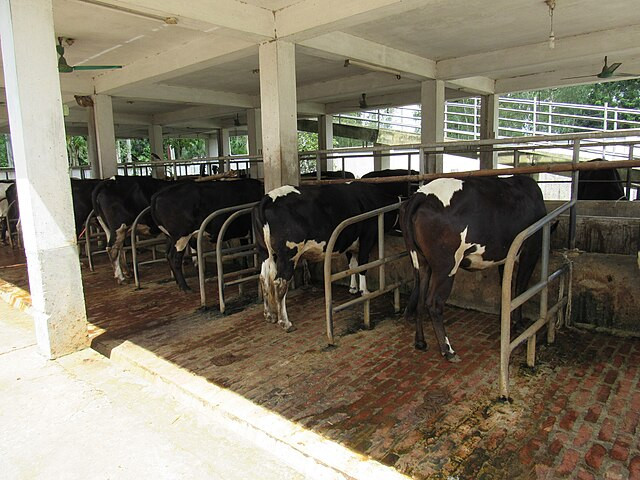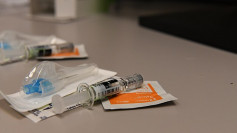California's dairy industry is facing an escalating health crisis as avian flu sweeps through the Central Valley, one of the nation's major milk-producing regions, during peak flu season. The outbreak, now affecting over 120 dairy herds, is sparking fears of a potential pandemic should the virus mutate and spread among humans. This development has heightened worries among public health officials about the risk of a more virulent strain emerging, which could pose a significant threat to global health.
The virus, which has been reported in several other states this year, including Colorado and Texas, is now raising alarm bells due to its timing and location. California's Central Valley is home to over 1.7 million cows, and the confluence of avian flu with seasonal flu creates an environment ripe for viral reassortment-a process by which two viruses combine to form a new, potentially more dangerous strain. The possibility of avian flu adapting to human transmission has experts on edge. Michael Mina, chief science officer at eMed, remarked, "It will mutate to become increasingly optimal in humans as soon as it gains any foot in the door for human-to-human transmission."
Since the outbreak began in August, California has confirmed 11 human infections, all linked to dairy workers who had direct contact with infected cows. While state health officials emphasize that no evidence of human-to-human transmission has been detected so far, experts are concerned that not enough is being done to contain the spread. Jennifer Nuzzo, director of the Pandemic Center at Brown University School of Public Health, voiced her frustration, noting the lack of detailed data about the infections, such as symptom onset dates, which could be critical in assessing the virus's spread.
The California Department of Public Health (CDPH) has only tested 25 individuals for avian flu since the outbreak began, focusing on those showing symptoms. With more than 17,500 dairy workers in the region, public health experts argue that testing needs to be scaled up significantly. To assist in the containment effort, the Centers for Disease Control and Prevention (CDC) has allocated over 100,000 doses of seasonal flu vaccine to 12 states, including 5,000 for California dairy workers. The aim is to reduce the prevalence of seasonal flu symptoms, making it easier to identify potential avian flu cases.
Past pandemics, such as the 2009 swine flu outbreak, have highlighted the dangers of viral reassortment. The swine flu was a combination of swine, avian, and human flu genes, resulting in millions of infections and thousands of deaths. Michael Mina warned that the current avian flu situation could lead to a similarly dangerous scenario if left unchecked. "The stakes are incredibly high," he said, pointing to the increased risk of hospitalizations and fatalities if a more pathogenic strain were to develop.
California has taken proactive steps, such as testing dairy herds for the virus and providing antivirals to infected individuals and their close contacts. However, many experts believe that these efforts fall short. Broader testing and more rigorous surveillance are necessary to get ahead of the virus. Dr. Meghan Davis, an associate professor at the Johns Hopkins Bloomberg School of Public Health, emphasized the need for additional worker support beyond the provision of personal protective equipment (PPE). "We need to be thinking about ways of supporting our workforce, more than just recommending PPE," she said.
Animal health measures have also ramped up. The California Department of Food and Agriculture has significantly increased bulk testing of dairy herds, especially in the Central Valley. Currently, more than 350 dairies, comprising over one million cattle, are undergoing testing. Anja Raudabaugh, CEO of Western United Dairies, highlighted that the extreme heat in the region has exacerbated the situation, with mortality rates as high as 15-20% in affected herds. By comparison, other states have reported mortality rates of just 2%. The intense heat has worsened symptoms in cows, leading to increased fatalities and reduced milk production.
The spike in cattle deaths has also overwhelmed rendering companies, which process carcasses. With the increased workload, some farmers have had to leave dead cows outside for days, raising concerns about further virus spread via scavengers. State officials insist that rendering capacity is sufficient, but delays in carcass collection have nevertheless been reported, adding another layer of complexity to the containment effort.
California's experience with the COVID-19 pandemic has informed some aspects of its response to the avian flu outbreak. The state has reopened a mass procurement system for PPE and is utilizing CalCONNECT, an IT system developed during the pandemic, to streamline data collection and coordination among local health departments. Additionally, the state has collaborated with dairy cooperatives to distribute PPE to farms, aiming to protect dairy workers from exposure.
Public health officials have also pushed for seasonal flu vaccinations among dairy workers to help distinguish avian flu cases from regular flu. Mobile clinics and walk-up vaccination sites have been set up to reach workers in rural areas, with an emphasis on keeping workers healthy and preventing further spread of the virus. Carrie Monteiro, spokesperson for Tulare County Health and Human Services, noted that relationships built during COVID-19 outreach have proven beneficial in facilitating the current vaccination campaign.
However, significant challenges remain. Experts stress that more financial support is needed for dairy workers, many of whom cannot afford to take time off work if they fall ill. The Central Valley counties are attempting to maintain a unified response, sending out joint advisories to healthcare providers and encouraging testing and reporting of cases among dairy workers. Amy Liebman of the Migrant Clinicians Network emphasized the importance of timely information, stating, "The bottom line is we don't really have the documentation that we need. We're not testing everybody, and so I don't think we really understand the extent of it at all."






